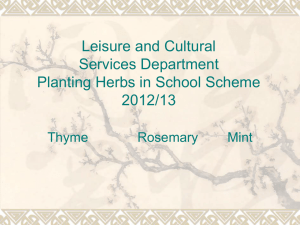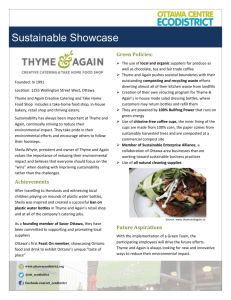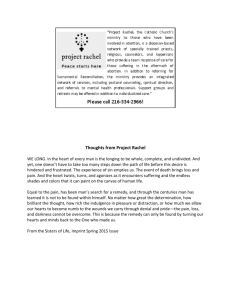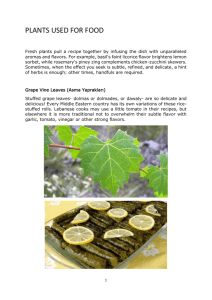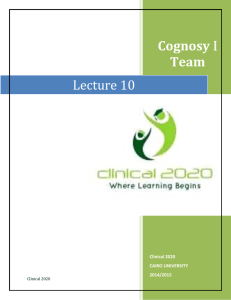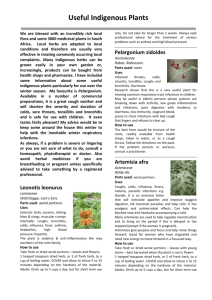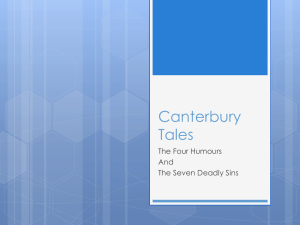Arctostaphylos uva-ursi (Spreng
advertisement
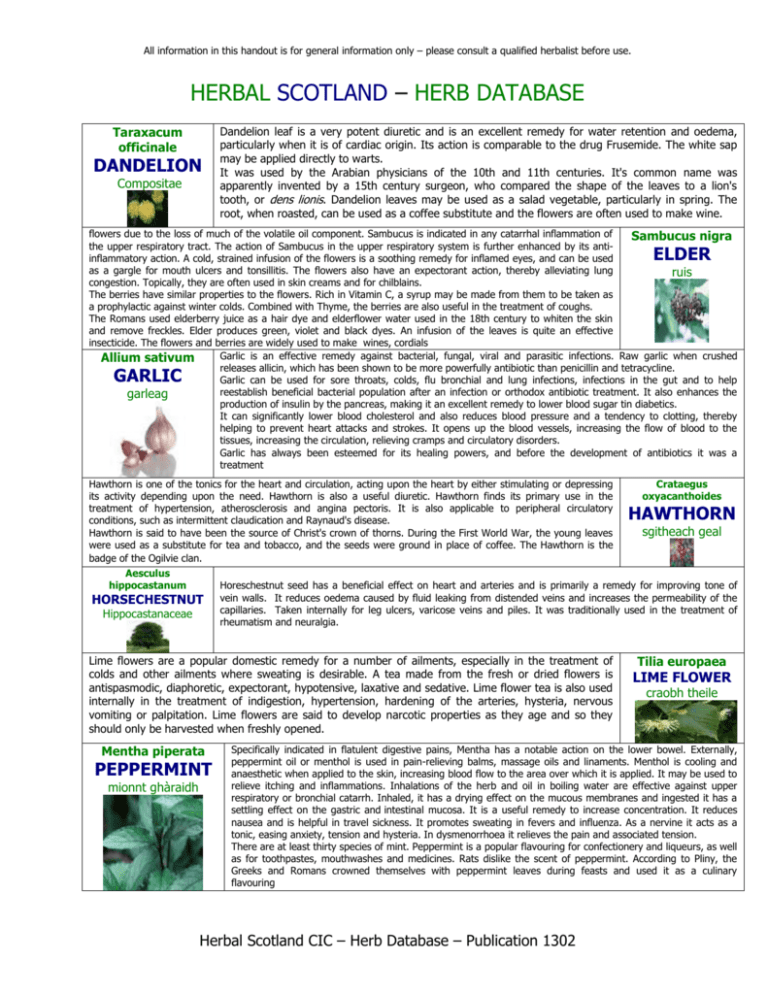
All information in this handout is for general information only – please consult a qualified herbalist before use. HERBAL SCOTLAND – HERB DATABASE Taraxacum officinale DANDELION Compositae Dandelion leaf is a very potent diuretic and is an excellent remedy for water retention and oedema, particularly when it is of cardiac origin. Its action is comparable to the drug Frusemide. The white sap may be applied directly to warts. It was used by the Arabian physicians of the 10th and 11th centuries. It's common name was apparently invented by a 15th century surgeon, who compared the shape of the leaves to a lion's tooth, or dens lionis. Dandelion leaves may be used as a salad vegetable, particularly in spring. The root, when roasted, can be used as a coffee substitute and the flowers are often used to make wine. flowers due to the loss of much of the volatile oil component. Sambucus is indicated in any catarrhal inflammation of Sambucus nigra the upper respiratory tract. The action of Sambucus in the upper respiratory system is further enhanced by its antiinflammatory action. A cold, strained infusion of the flowers is a soothing remedy for inflamed eyes, and can be used as a gargle for mouth ulcers and tonsillitis. The flowers also have an expectorant action, thereby alleviating lung ruis congestion. Topically, they are often used in skin creams and for chilblains. The berries have similar properties to the flowers. Rich in Vitamin C, a syrup may be made from them to be taken as a prophylactic against winter colds. Combined with Thyme, the berries are also useful in the treatment of coughs. The Romans used elderberry juice as a hair dye and elderflower water used in the 18th century to whiten the skin and remove freckles. Elder produces green, violet and black dyes. An infusion of the leaves is quite an effective insecticide. The flowers and berries are widely used to make wines, cordials Garlic is an effective remedy against bacterial, fungal, viral and parasitic infections. Raw garlic when crushed Allium sativum releases allicin, which has been shown to be more powerfully antibiotic than penicillin and tetracycline. Garlic can be used for sore throats, colds, flu bronchial and lung infections, infections in the gut and to help reestablish beneficial bacterial population after an infection or orthodox antibiotic treatment. It also enhances the garleag production of insulin by the pancreas, making it an excellent remedy to lower blood sugar tin diabetics. It can significantly lower blood cholesterol and also reduces blood pressure and a tendency to clotting, thereby helping to prevent heart attacks and strokes. It opens up the blood vessels, increasing the flow of blood to the tissues, increasing the circulation, relieving cramps and circulatory disorders. Garlic has always been esteemed for its healing powers, and before the development of antibiotics it was a treatment ELDER GARLIC Hawthorn is one of the tonics for the heart and circulation, acting upon the heart by either stimulating or depressing its activity depending upon the need. Hawthorn is also a useful diuretic. Hawthorn finds its primary use in the treatment of hypertension, atherosclerosis and angina pectoris. It is also applicable to peripheral circulatory conditions, such as intermittent claudication and Raynaud's disease. Hawthorn is said to have been the source of Christ's crown of thorns. During the First World War, the young leaves were used as a substitute for tea and tobacco, and the seeds were ground in place of coffee. The Hawthorn is the badge of the Ogilvie clan. Aesculus hippocastanum HORSECHESTNUT Hippocastanaceae PEPPERMINT mionnt ghàraidh HAWTHORN sgitheach geal Horeschestnut seed has a beneficial effect on heart and arteries and is primarily a remedy for improving tone of vein walls. It reduces oedema caused by fluid leaking from distended veins and increases the permeability of the capillaries. Taken internally for leg ulcers, varicose veins and piles. It was traditionally used in the treatment of rheumatism and neuralgia. Lime flowers are a popular domestic remedy for a number of ailments, especially in the treatment of colds and other ailments where sweating is desirable. A tea made from the fresh or dried flowers is antispasmodic, diaphoretic, expectorant, hypotensive, laxative and sedative. Lime flower tea is also used internally in the treatment of indigestion, hypertension, hardening of the arteries, hysteria, nervous vomiting or palpitation. Lime flowers are said to develop narcotic properties as they age and so they should only be harvested when freshly opened. Mentha piperata Crataegus oxyacanthoides Tilia europaea LIME FLOWER craobh theile Specifically indicated in flatulent digestive pains, Mentha has a notable action on the lower bowel. Externally, peppermint oil or menthol is used in pain-relieving balms, massage oils and linaments. Menthol is cooling and anaesthetic when applied to the skin, increasing blood flow to the area over which it is applied. It may be used to relieve itching and inflammations. Inhalations of the herb and oil in boiling water are effective against upper respiratory or bronchial catarrh. Inhaled, it has a drying effect on the mucous membranes and ingested it has a settling effect on the gastric and intestinal mucosa. It is a useful remedy to increase concentration. It reduces nausea and is helpful in travel sickness. It promotes sweating in fevers and influenza. As a nervine it acts as a tonic, easing anxiety, tension and hysteria. In dysmenorrhoea it relieves the pain and associated tension. There are at least thirty species of mint. Peppermint is a popular flavouring for confectionery and liqueurs, as well as for toothpastes, mouthwashes and medicines. Rats dislike the scent of peppermint. According to Pliny, the Greeks and Romans crowned themselves with peppermint leaves during feasts and used it as a culinary flavouring Herbal Scotland CIC – Herb Database – Publication 1302 All information in this handout is for general information only – please consult a qualified herbalist before use. In Gaelic this herb is known as The healing plant and highland tradition notes that the top of the leaf is used to stop bleeding whilst the underside of the leaf is used to draw out infection. It clears heat, congestion and toxins from the body, useful in treating fevers, infections and skin problems. Its mucilage has a soothing effect particularly in the respiratory, digestive and urinary systems. Plaintain depresses the secretion of mucous, cuach Phàdraig particularly in the respiratory systems, useful when treating colds, catarrh, sinusitis, bronchial congestion and allergic conditions such as hay fever and asthma. Its expectorant action clears phlegm from the chest. It can be used for catarrhal congestion in the middle ear, glue ear and ear infections. Plantain is a useful remedy for prostatic enlargement. Nettle is rich in iron and vitamin C, making it a useful remedy in anaemia and other debilitated states, the Urtica dioica presence of the vitamin C ensuring that the iron is properly absorbed. The herb has an important effect on the kidney and on fluid and uric acid excretion, so is of benefit in gout and other arthritic conditions, A tincture of the fresh leaf applied locally to an inflamed joint will induce counter-irritation and produce feanntag, neandog, reddening over the joint. Blood is thus flushed through the area and out to the surface of the skin. Nettle also has an anti-allergic property useful for allergic conditions such as urticaria. The root is beneficial for prostate problems in men. The Romans treated rheumatic conditions by flaying their joints with fresh nettles so as to stimulate blood circulation. Nettles are a good source of chlorophyll and are a traditional spring tonic. In spring, the fresh green leaves can be cooked and eaten like spinach or made into a soup. Rosemary is specifically indicated in depressive states accompanied by general debility and indications of Rosmarinus cardiovascular weakness and is of value as a tonic for elderly people with weak circulation, particularly after a officinalis debilitating illness such as influenza and pneumonia. The herb is of benefit in palpitations and other signs of nervous tension which affect the circulation. The herb reduces flatulence and is stimulating to the digestion, liver and gallbladder. An infusion makes a good mouthwash for halitosis. ròs Mhuire Externally, Rosemary is used to ease muscular pain, sciatica and neuralgia, and the oil is a component of liniments used for rheumatism. A salve made from the oil can be applied to sores, eczema, bruises and wounds. It is an excellent remedy for headache, taken either as an infusion or by applying the oil to the temples. It has been used since ancient times to improve and strengthen the memory. Rosemary was reputedly first grown in England by Philippa of Hainault, wife of Edward III, in the 14th century. Gerard said of the herb, 'it comforteth the harte and maketh it merie'. It is said that rosemary grows well in the kitchen gardens of households where the woman reigns supreme. It is an ingredient of many shampoos and hair preparations. Plantago major PLANTAIN NETTLE ROSEMARY Sage deals effectively with throat infections, dental abscesses, infected gums and mouth ulcers. It Salvia officinalis can also be applied to external wounds. Salvia also has an astringent action and its antiseptic SAGE action is of value where there is intestinal infection. Sage has an antispasmodic action which slan lus reduces tension in smooth muscle. Its appreciable oestrogenic effect make it particularly beneficial for the night sweats of the menopause (it should never be used to suppress perspiration in fevers). Its oestrogenic effects may also be used to treat some cases of dysmenorrhoea and menstrual irregularity or amenorrhoea. It is effective in reducing milk production, and can be used during the process of weaning an infant off the breast The leaves are anticholesterolemic and diuretic. An infusion of the leaves is used in the treatment of Betula pendula gout, dropsy and rheumatism The young leaves and leaf buds are harvested in the spring and dried SILVER BIRCH for later use. A decoction of the leaves and bark is used for bathing skin eruptions. Betulaceae Stellaria media Chickweed is a nutrient rich herb, packed with vitamins A and C and plenty of mineral including iron. It has a light refreshing taste which can be added to salads. Apply cooling chickweed ointment to skins problems such as eczema and sunburn to speed healing and to relieve itching. It can calm inflammation in the gut and respiratory tract, making it good for gastritis, asthma and bronchitis. As a diuretic it helps to expel toxins that exacerbate arthritis and gout. Apply the fresh leaves to scalds, bruises, ulcers and hemorrhoids. Thymus vulgaris THYME Labiatae CHICKWEED fliodh Thyme is beneficial in nervous, exhausted or depressed states. For adults and children alike, warming, gentle thyme is both expectorant and relaxant and will help soothe bronchitis, pneumonia and other respiratory infections. It is also indicated for nervous coughs, asthma and whooping cough. In the gut thyme will relieve spasm and fight infections and in arthritis, thyme’s diuretic properties which help to expel toxins from the body. Thymol is twenty times more antiseptic than phenol and the small proportion of thymol that is absorbed into the bloodstream carries the antiseptic effect to the lungs and kidneys where it is excreted from the body in the urine and on the breath. Thyme is an effective topical anti-fungal treatment which gives relief to muscular pain and itching and can be used as a mouthwash and gargle. The Romans used thyme to impart an aromatic flavour to cheese and liqueurs and in ancient Athens, thyme honey was prized. According to Culpeper, thyme is 'a noble strengthener of the lungs. Thymol is a popular ingredient of mouthwashes and toothpastes and is one of the components of several herbal liniments used to relieve arthritic and muscular pain. Herbal Scotland CIC – Herb Database – Publication 1302
